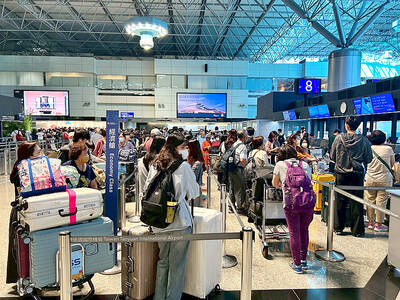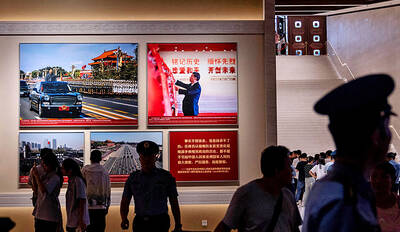About 60 percent of parents believe body safety and boundaries are suitable to be taught to children aged between five and eight, and other aspects of sex education should be taught to students between 15 and 18, a poll conducted by a local association found.
The poll was conducted by the Taiwan Association for Sexuality Education and Action Alliance on Basic Education from April 10 through May 12 and received 1,203 valid responses.
The poll wanted to gauge parents’ thoughts on how the three core concepts of general sex education — values, rights, culture and sex; sex and sexual behavior; and sex and reproductive health — should be taught and what age groups they are suitable for, Action Alliance on Basic Education chairman Wang Han-yang (王瀚陽) said.

Photo: Lai Hsiao-tung, Taipei Times
Respondents said it was suitable to teach elementary-school children about self-protection, puberty, family, gender and roles, asking adults for help and not discriminating against those with different sexual orientations.
More than 60 percent of respondents said elementary school children should be taught about physical boundaries.
A Taiwan Local Sexuality Education Needs census showed that more than 60 percent felt sex education pertaining to body boundaries should be taught to children aged five to eight, while sex-related content should be taught to students around 15 to 18 years old.
Of the 49 topics available, parents felt 33 were suitable to be taught to children in junior-high school.
Respondents said 19 of the questions should be discussed with adolescents, while eight of the questions should be taught to younger children.
Taiwan Association for Sexuality Education vice chairman Feng Chia-yu (馮嘉玉) said issues on physical boundaries, self-protection and mitigating sex-related risks in Taiwan were introduced ahead of the recommended age as suggested by the UN.
However, parents’ responses to questions on sexual attraction and sexual pleasure, such as recommending that they be delayed beyond the age recommended by the UN, shows it is unsuitable to fully introduce foreign policies and experiences on the issue in Taiwan, Feng said.

Three batches of banana sauce imported from the Philippines were intercepted at the border after they were found to contain the banned industrial dye Orange G, the Food and Drug Administration (FDA) said yesterday. From today through Sept. 2 next year, all seasoning sauces from the Philippines are to be subject to the FDA’s strictest border inspection, meaning 100 percent testing for illegal dyes before entry is allowed, it said in a statement. Orange G is an industrial coloring agent that is not permitted for food use in Taiwan or internationally, said Cheng Wei-chih (鄭維智), head of the FDA’s Northern Center for

The Chinese military has built landing bridge ships designed to expand its amphibious options for a potential assault on Taiwan, but their combat effectiveness is limited due to their high vulnerability, a defense expert said in an analysis published on Monday. Shen Ming-shih (沈明室), a research fellow at the Institute for National Defense and Security Research, said that the deployment of such vessels as part of the Chinese People’s Liberation Army (PLA) Navy’s East Sea Fleet signals a strong focus on Taiwan. However, the ships are highly vulnerable to precision strikes, which means they could be destroyed before they achieve their intended

About 4.2 million tourist arrivals were recorded in the first half of this year, a 10 percent increase from the same period last year, the Tourism Administration said yesterday. The growth continues to be consistent, with the fourth quarter of this year expected to be the peak in Taiwan, the agency said, adding that it plans to promote Taiwan overseas via partnerships and major events. From January to June, 9.14 million international departures were recorded from Taiwan, an 11 percent increase from the same period last year, with 3.3 million headed for Japan, 1.52 million for China and 832,962 to South Korea,

REWRITING HISTORY: China has been advocating a ‘correct’ interpretation of the victory over Japan that brings the CCP’s contributions to the forefront, an expert said An elderly Chinese war veteran’s shin still bears the mark of a bullet wound he sustained when fighting the Japanese as a teenager, a year before the end of World War II. Eighty years on, Li Jinshui’s scar remains as testimony to the bravery of Chinese troops in a conflict that killed millions of their people. However, the story behind China’s overthrow of the brutal Japanese occupation is deeply contested. Historians broadly agree that credit for victory lies primarily with the Chinese Nationalist Party (KMT)-led Republic of China (ROC) Army. Its leader, Chiang Kai-shek (蔣介石), fled to Taiwan in 1949 after losing a